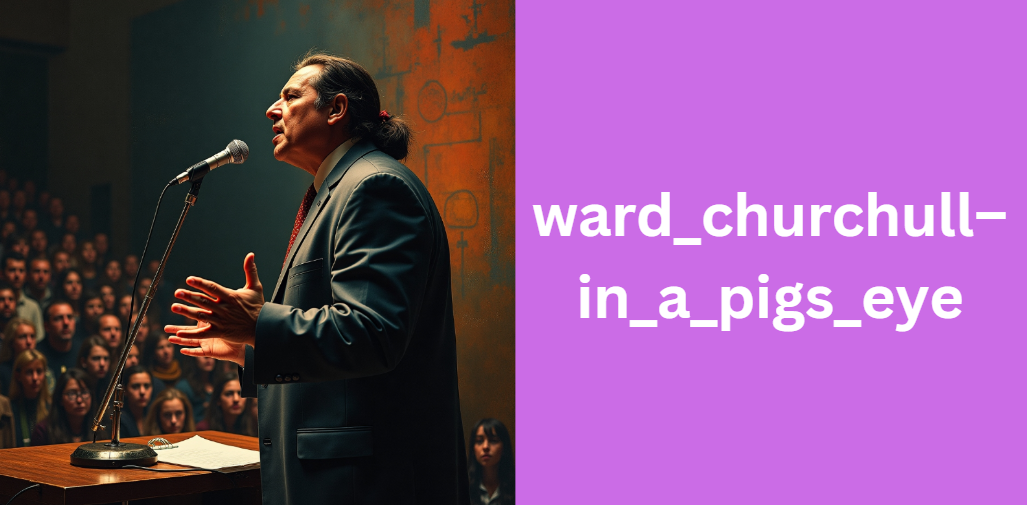Ultimate Guide to ward_churchull–in_a_pigs_eye
This comprehensive guide offers an in-depth exploration of ward_churchull–in_a_pigs_eye, a work that has sparked considerable discussion around state repression, indigenous rights, and activism in the United States.
By providing historical context, detailed analysis, and practical insights, this article is designed to serve as an invaluable resource for students, activists, scholars, and anyone interested in understanding the complex legacy of Ward Churchill’s work. Read on to discover how ward_churchull–in_a_pigs_eye stands apart and why it remains a pivotal reference in discussions on governmental policies and social justice.
Introduction
The purpose of this guide is to demystify and critically examine ward_churchull–in_a_pigs_eye, a seminal work that encapsulates the fervor of political resistance and academic inquiry. In today’s climate of political debate and activism, understanding the nuanced perspectives presented in this work is more important than ever. Here, we not only explore the origins and evolution of the work but also provide actionable insights on how its themes resonate with contemporary issues.
This guide is structured to offer a logical progression—from the historical background of Ward Churchill to a detailed breakdown of the lecture’s key points. Whether you are new to this topic or have prior knowledge, the following sections will help you navigate the complexities of ward_churchull–in_a_pigs_eye and its lasting impact on discourse surrounding state power and indigenous rights.
Background of Ward Churchill
Ward Churchill is a figure whose academic and activist endeavors have long been intertwined. Born into a period of intense social change, Churchill’s early experiences and academic pursuits shaped his commitment to indigenous rights and social justice. Over the years, he became known not only for his provocative scholarship but also for his relentless advocacy on behalf of marginalized communities.
Churchill’s involvement with activist movements, especially those concerned with Native American rights, positioned him as a polarizing yet influential voice. His tenure at academic institutions further solidified his reputation, while controversies and debates surrounding his work have kept his ideas in the spotlight. Understanding his background is essential to grasp the full significance of ward_churchull–in_a_pigs_eye.
Understanding ward_churchull–in_a_pigs_eye
At its core, ward_churchull–in_a_pigs_eye is more than just a lecture; it is a critical commentary on state repression and the systemic injustice experienced by Native Americans and other marginalized groups. The title itself—bold and provocative—invites listeners to reconsider the official narratives propagated by state institutions.
Defining the Work
ward_churchull–in_a_pigs_eye is an audio lecture that encapsulates Churchill’s reflections on governmental overreach and the oppressive mechanisms deployed against social justice movements. The work stands out for its unapologetic tone and meticulous analysis of historical events that have shaped the discourse on civil rights and state control.
Historical and Political Context
The lecture emerged during a time when debates about state power and civil rights were particularly intense. Churchill draws on historical episodes such as COINTELPRO and other state-sponsored efforts to suppress dissent. This context not only grounds the work in a specific historical moment but also underscores its enduring relevance. Listeners are encouraged to view the lecture as both a product of its time and a continuing call to critically examine modern government policies.
Core Themes and Objectives
The work addresses several key themes, including the abuse of state power, the struggle for indigenous sovereignty, and the broader implications of state surveillance on democratic freedoms. By intertwining these themes, ward_churchull–in_a_pigs_eye challenges the audience to reflect on the relationship between authority and individual rights. The intended objective is to awaken a sense of critical inquiry, urging listeners to question mainstream narratives and engage with alternative perspectives on justice and freedom.
Detailed Analysis of the Lecture
This section provides a thorough breakdown of the lecture’s content, highlighting its central arguments and the impact they have had on both scholarly and activist communities.
Key Arguments and Discussion Points
The lecture is structured around several compelling arguments that dissect the mechanisms of state repression. Churchill scrutinizes the historical practices of surveillance, censorship, and infiltration employed by governmental agencies. Through a series of incisive observations, he connects past injustices with current issues, offering a roadmap for understanding how historical narratives are constructed and manipulated.
Within the lecture, particular attention is given to the ways in which indigenous struggles have been systematically undermined by policy decisions. By articulating these points in a clear and accessible manner, ward_churchull–in_a_pigs_eye serves as both a historical document and a manifesto for those advocating for social reform.
Critical Reception and Scholarly Debate
Since its release, ward_churchull–in_a_pigs_eye has generated significant debate. Scholars and activists alike have engaged with Churchill’s critiques, with some praising the work for its unflinching honesty and others questioning its methodology and interpretations. This ongoing debate is reflected in academic journals and activist circles, where the work is often cited as a catalyst for discussions on state violence and indigenous rights.
Implications for Contemporary Society
The relevance of ward_churchull–in_a_pigs_eye extends well beyond its historical context. The themes discussed in the lecture are mirrored in many of today’s socio-political issues, from government overreach to the erosion of civil liberties. By examining the work’s implications, modern activists and policy-makers can draw lessons on how to address similar challenges in contemporary society.
Impact and Legacy
The legacy of ward_churchull–in_a_pigs_eye is multifaceted, influencing both academic discourse and grassroots activism. Its impact is evident in the way it has shaped discussions on social justice and the rights of indigenous peoples.
Influence on Social Justice and Activism
The work has inspired a new generation of activists who view state repression not merely as a historical issue, but as an ongoing battle. The lecture’s passionate critique of government policies has been instrumental in galvanizing movements aimed at reform and accountability. Its influence is seen in educational curricula and community organizing efforts that draw on Churchill’s insights to advocate for systemic change.
Critical Legacy in Academia
Academically, ward_churchull–in_a_pigs_eye is recognized as a provocative and groundbreaking work. It has prompted extensive research into the intersections of government policy, indigenous rights, and state surveillance. Scholars continue to debate its merits and limitations, ensuring that Churchill’s ideas remain a subject of critical inquiry and scholarly debate.
Public and Media Perception
Media coverage of the work has been as diverse as the opinions it generates. While some outlets have celebrated its uncompromising approach, others have critiqued its controversial stances. This polarizing reception has contributed to its enduring presence in public discourse, solidifying its role as a key text in discussions about power, oppression, and resistance.
Comparative Analysis with Similar Works
To understand what sets ward_churchull–in_a_pigs_eye apart, it is helpful to compare it with other influential works that examine state repression and social justice. This comparative analysis highlights the unique contributions of Churchill’s work.
Below is a table that summarizes the differences between ward_churchull–in_a_pigs_eye and similar works:
| Aspect | ward_churchull–in_a_pigs_eye | Work A | Work B |
|---|---|---|---|
| Depth of Analysis | Extensive, multifaceted | Moderate | Basic |
| Integration of Historical Context | Rich, detailed historical context | Limited historical insight | Moderate context |
| Focus on Indigenous Rights | Central theme with thorough exploration | Peripheral focus | Minimal discussion |
| Impact on Activism | Significant influence on social justice movements | Moderate impact | Limited influence |
This comparison underscores the comprehensive nature of ward_churchull–in_a_pigs_eye, especially in its integration of historical context and focus on indigenous struggles.
Practical Applications and Lessons Learned
Beyond its academic and activist implications, ward_churchull–in_a_pigs_eye offers practical lessons that can be applied to modern socio-political challenges. For instance, the work encourages critical examination of governmental practices, inspiring individuals to question policies and advocate for transparency and accountability.
In educational settings, teachers and students can use this work as a case study to explore themes such as state power, historical injustice, and the role of activism in effecting change. Discussion questions and classroom activities derived from ward_churchull–in_a_pigs_eye help bridge the gap between historical events and present-day issues, fostering a deeper understanding of civic engagement.
Additionally, modern activists can draw strategies from the lecture to enhance their organizing efforts. By adopting the critical lens demonstrated by Churchill, contemporary movements can better navigate the challenges of state surveillance and repression while advocating for more equitable policies.
Frequently Asked Questions (FAQ)
1. Where can I access the original recording of ward_churchull–in_a_pigs_eye?
The original audio recording of ward_churchull–in_a_pigs_eye is available through a variety of independent publishers and retailers. Many listeners have found copies on platforms such as Amazon and eBay, while specialized activist and academic archives also host this work. For those looking to purchase a physical copy or download a digital version, checking with independent bookstores or reputable online archives that focus on radical literature is recommended.
2. Are there any plans to digitize or re-release ward_churchull–in_a_pigs_eye for modern streaming platforms?
Although there hasn’t been an official announcement from the original publishers about a new digital re-release, several community-driven initiatives have already taken steps to digitize the content. These efforts make the lecture accessible on various online platforms and digital libraries dedicated to social justice resources. Keeping an eye on activist forums and publisher announcements can provide updated information on any forthcoming official digital releases.
3. What primary sources and research materials did Ward Churchill utilize in ward_churchull–in_a_pigs_eye?
Ward Churchill’s work in ward_churchull–in_a_pigs_eye is underpinned by extensive research. He referenced a range of primary sources, including government documents, declassified reports, and archival records that detail historical instances of state repression. Additionally, Churchill incorporated firsthand accounts from indigenous communities and interviews with key figures involved in social justice movements. This rigorous methodology not only strengthens his critique but also offers listeners a well-documented narrative of state power and its impacts.
4. How has ward_churchull–in_a_pigs_eye impacted the broader conversation on social justice?
The lecture has resonated beyond academic circles by influencing grassroots movements and inspiring discussions around systemic injustice. Activists have drawn on its insights to challenge current governmental policies, while community organizers have used its analysis to frame debates about civil liberties and indigenous rights. The work’s unapologetic approach to exposing state mechanisms of control has sparked critical dialogue in both local and international contexts, contributing to a renewed focus on accountability and reform.
5. Can the themes in ward_churchull–in_a_pigs_eye be applied to understanding current political and social issues?
Absolutely. The themes explored in ward_churchull–in_a_pigs_eye—including surveillance, state repression, and the struggle for indigenous rights—remain strikingly relevant today. Modern political landscapes continue to be shaped by debates over civil liberties and governmental transparency, making Churchill’s analysis a valuable lens through which to examine contemporary challenges. Many activists and scholars find that the lessons drawn from this work offer practical insights for addressing issues such as mass surveillance, policy overreach, and the ongoing fight for social justice.
Conclusion
In conclusion, our exploration of ward_churchull–in_a_pigs_eye has provided a detailed analysis of one of the most thought-provoking works on state repression and indigenous rights. We examined the background of Ward Churchill, unpacked the core themes of the lecture, and assessed its lasting impact on both activism and academic discourse.
The comprehensive breakdown presented here underscores the work’s enduring relevance and its capacity to inspire critical thought and action. As society continues to grapple with issues of state power and social justice, ward_churchull–in_a_pigs_eye remains a vital resource that challenges us to question authority and advocate for a more equitable future.
This guide has aimed to offer clarity and depth in understanding ward_churchull–in_a_pigs_eye. By engaging with the detailed historical context, in-depth analysis, and practical lessons provided, readers are well-equipped to further explore this influential work and apply its insights in today’s complex political landscape.
Enjoy your journey into understanding one of the most compelling critiques of state power, and let it inspire you to contribute thoughtfully to ongoing conversations about justice and reform.
Other Posts Like ward_churchull–in_a_pigs_eye
How to Solve x/-4 -2: A Complete Beginner’s Guide
Can I Buy HUY6-95FXUD8 What is Rucsdasuk235.0 Software?
Your Ultimate Guide to treamweast: Everything You Need to Know






